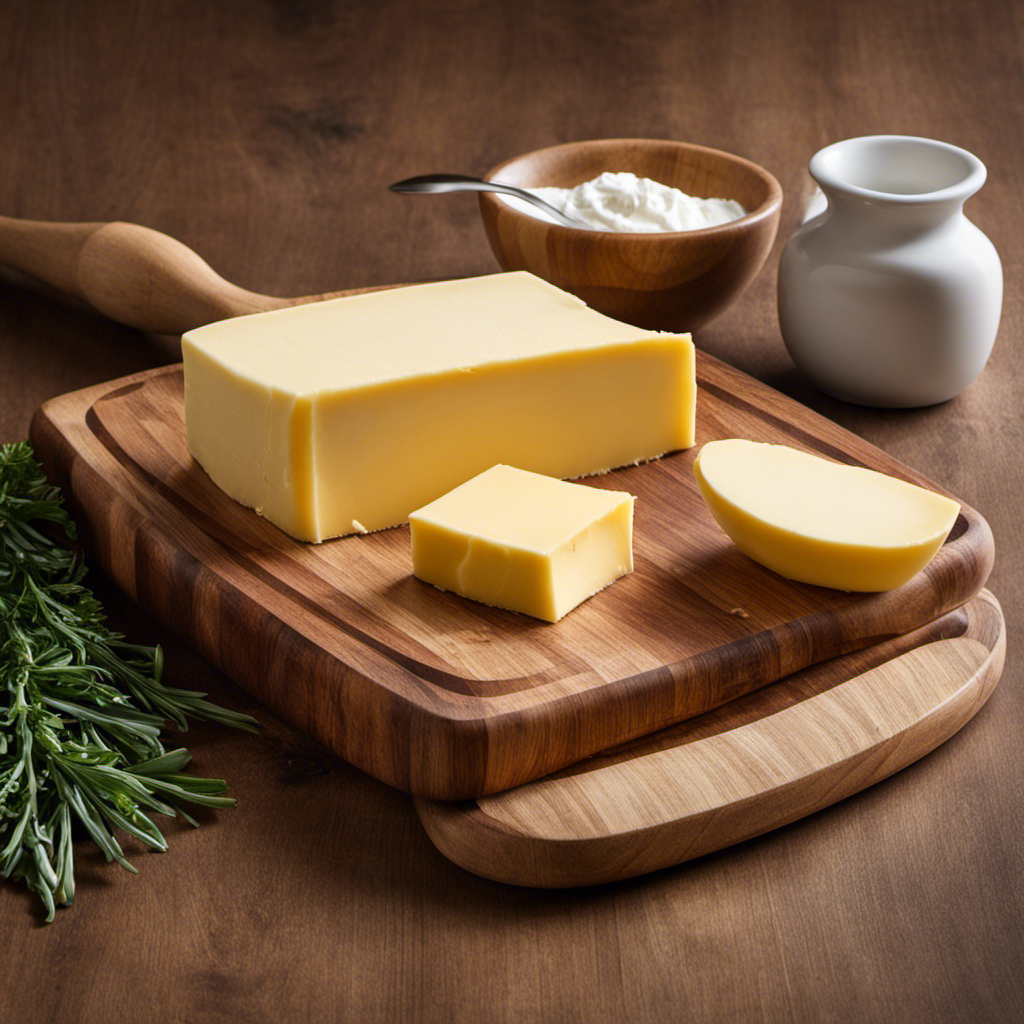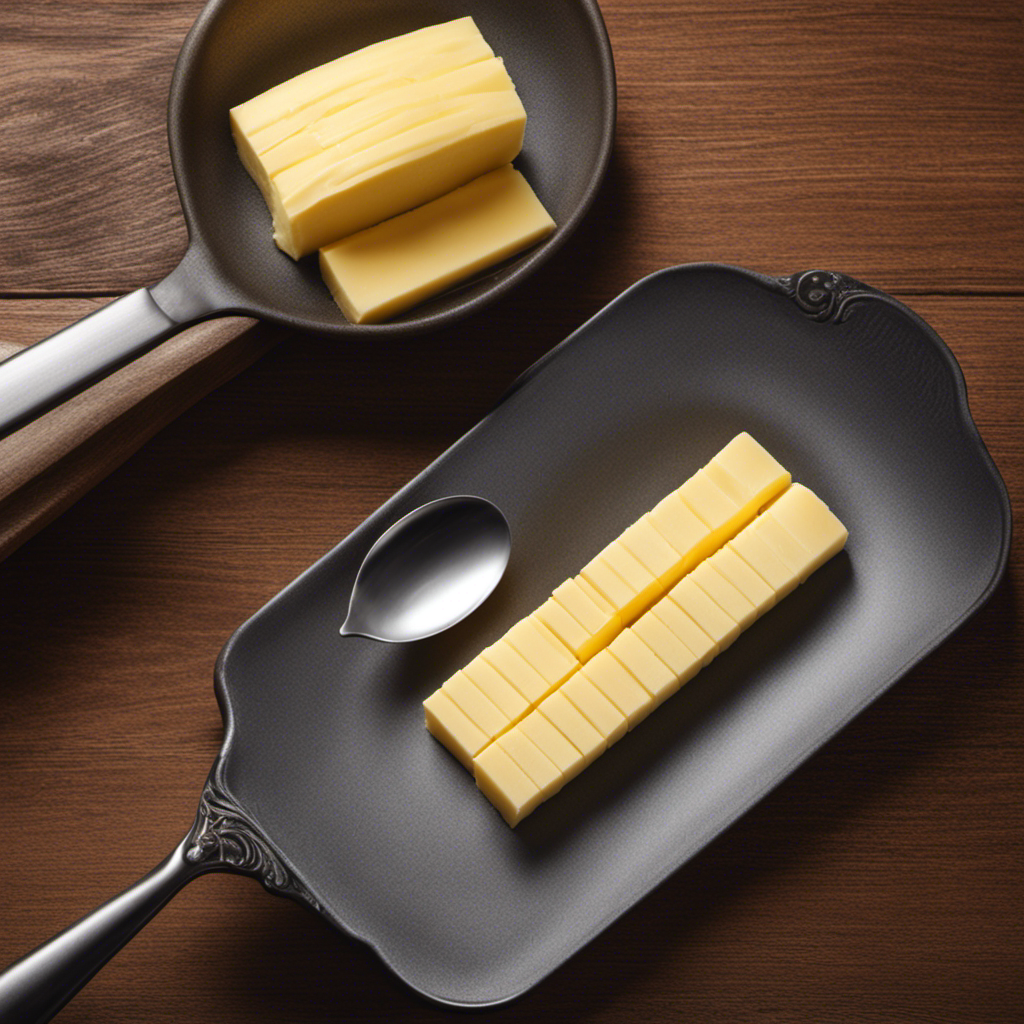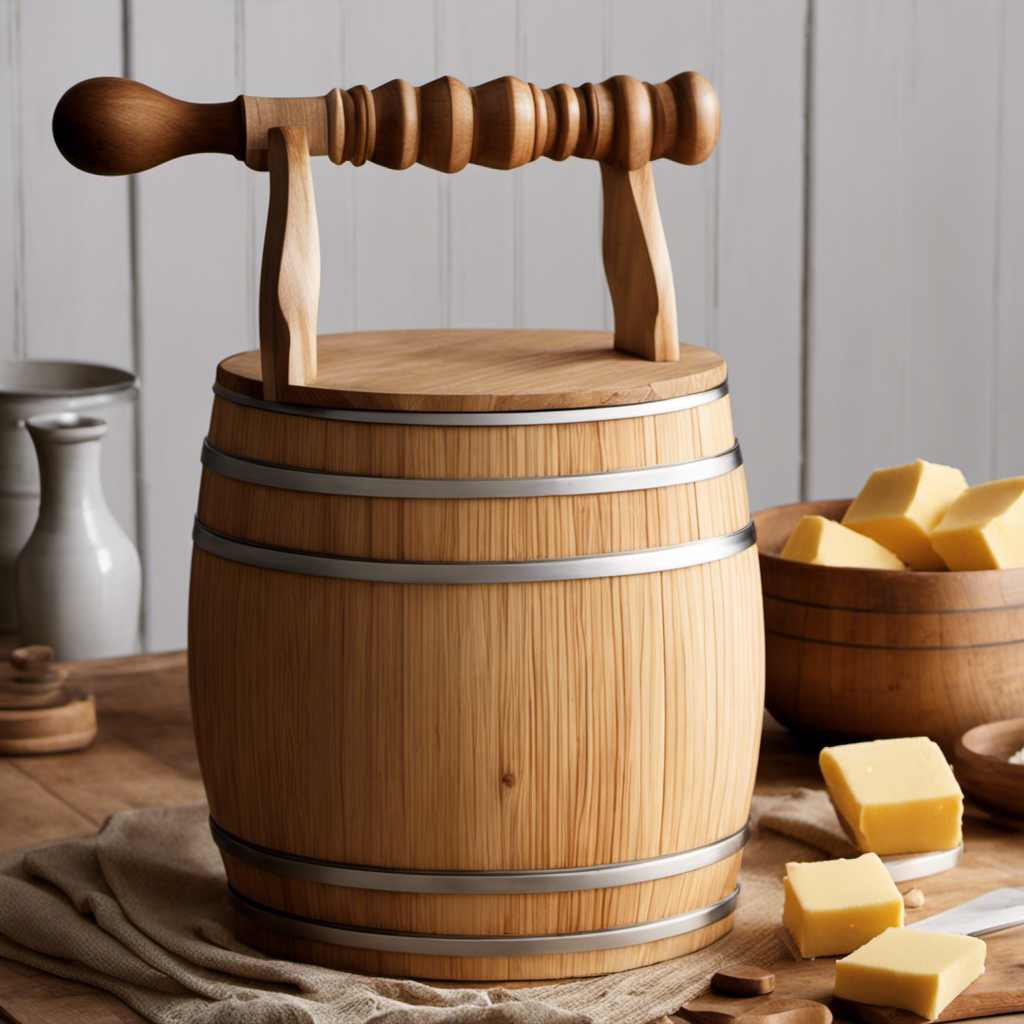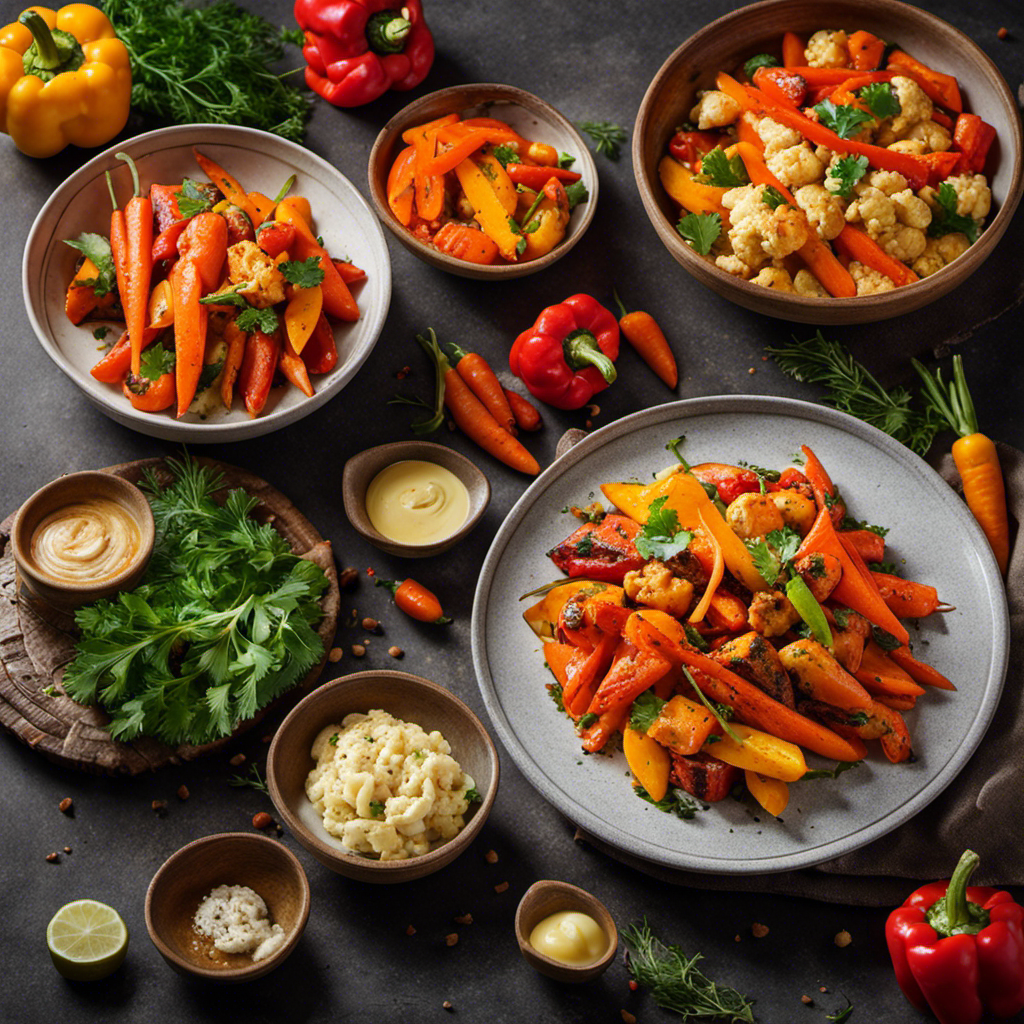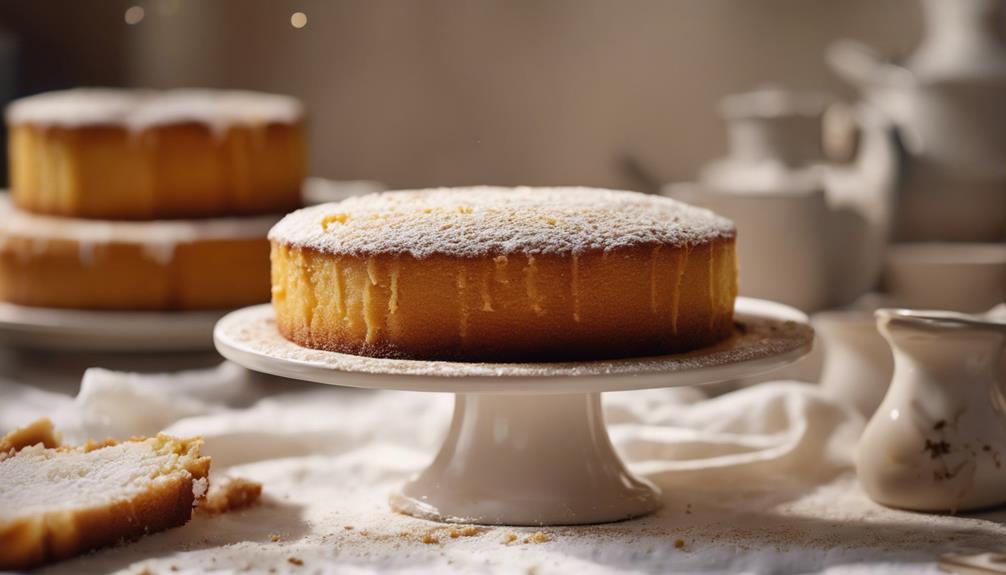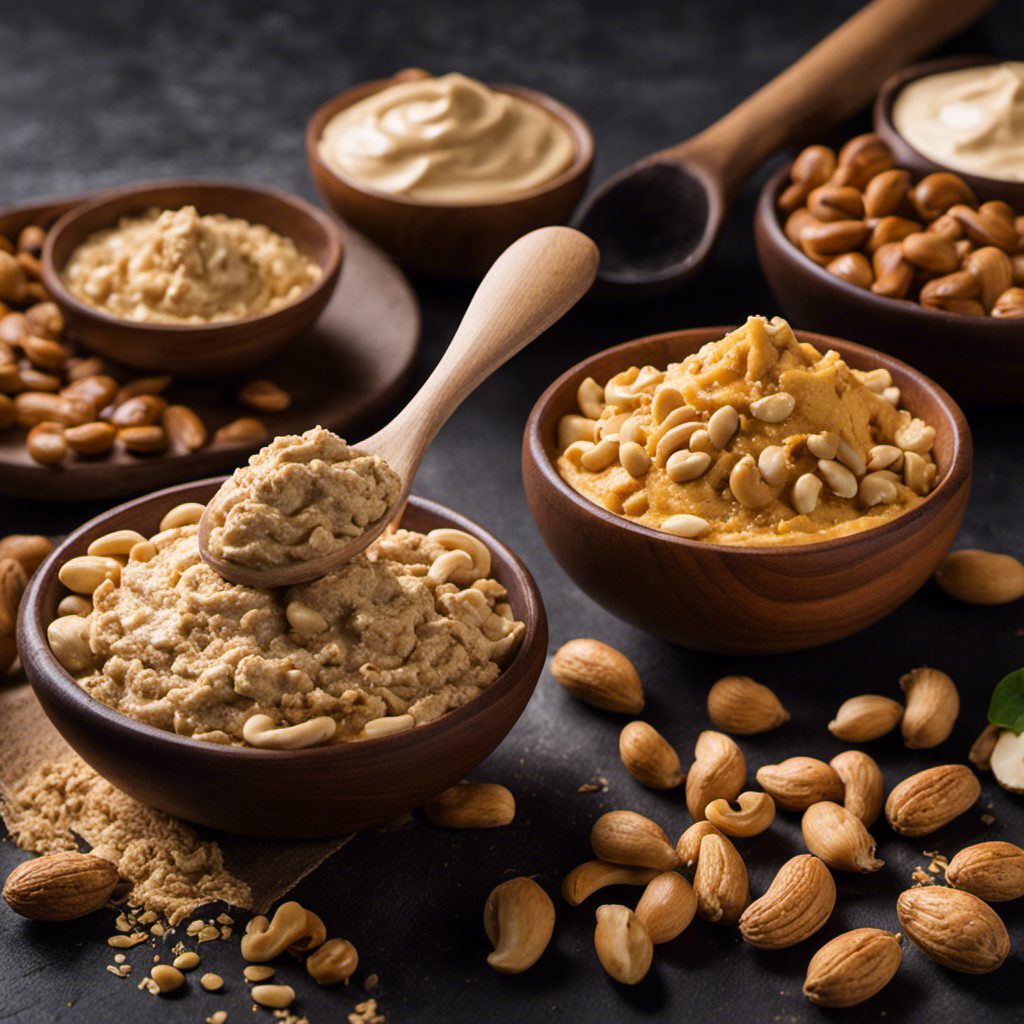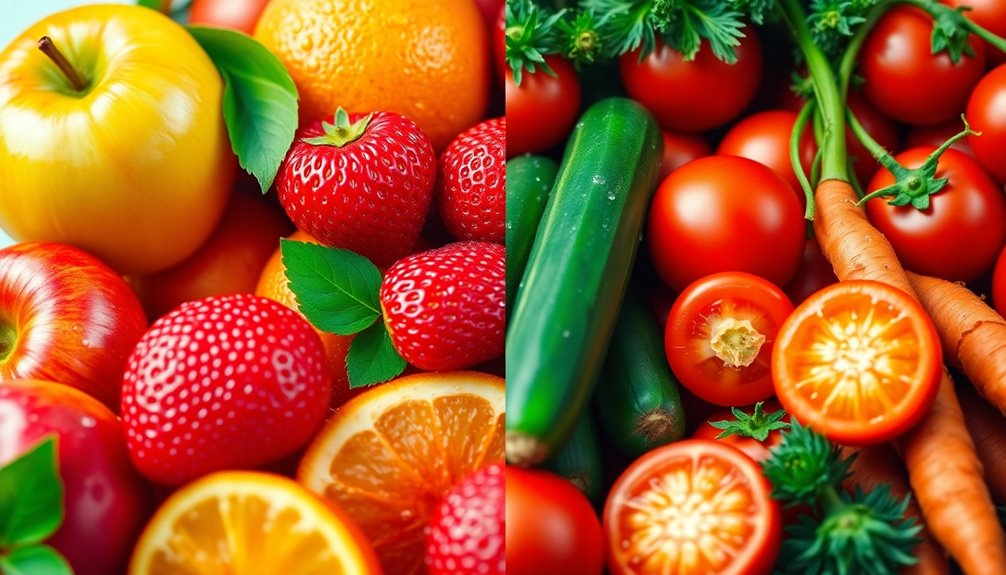As someone who loves butter, I have frequently pondered how many tablespoons are in a stick of this delicious creamy goodness. If you have ever found yourself wondering the same thing, do not worry! In this article, I will solve the mystery and give you the exact answer.
Understanding butter measurements in tablespoons is crucial for any home cook or baker. So, let’s dive in and calculate the number of tablespoons in a stick of butter together.
Key Takeaways
- A stick of butter is equal to 8 tablespoons.
- One stick of butter contains 1/2 cup.
- Using a butter dish with tablespoon markings ensures accurate measurements.
- Knowing the stick to tablespoon ratio allows for easy conversions.
Conversion of Stick of Butter to Tablespoons
You can easily convert a stick of butter to tablespoons by multiplying it by 8.
Understanding butter equivalents and converting butter measurements is important in cooking and baking. Butter is often measured in sticks, but many recipes require measurements in tablespoons.
To convert a stick of butter to tablespoons, you need to know that a stick of butter is equal to 8 tablespoons. This conversion is based on the fact that one stick of butter contains 1/2 cup, and there are 16 tablespoons in a cup.
Therefore, by multiplying the number of sticks by 8, you can quickly determine the equivalent number of tablespoons. For example, if a recipe calls for 2 sticks of butter, you would need 16 tablespoons.
Understanding this conversion allows you to accurately measure and use butter in your recipes.
Understanding Butter Measurements in Tablespoons
Understanding how measurements of butter are typically expressed in tablespoons can be helpful when following recipes. Here are three alternative ways to measure butter:
-
Using a kitchen scale: Many professional chefs and bakers prefer to measure butter by weight rather than volume. By weighing butter in grams or ounces, you can achieve greater accuracy in your recipe.
-
Using butter sticks: Butter is often sold in pre-measured sticks, usually 4 ounces or 113 grams each. These sticks are conveniently divided into tablespoons, making it easy to measure the desired amount.
-
Using tablespoons and teaspoons: If you don’t have a kitchen scale or butter sticks, you can use tablespoons and teaspoons to measure butter. One tablespoon of butter is equal to 1/8 of a standard stick.
Understanding these alternative ways to measure butter in tablespoons will allow you to adapt to different recipes and ensure accurate measurements. Now, let’s move on to calculating the number of tablespoons in a stick of butter.
Calculating the Number of Tablespoons in a Stick of Butter
To calculate the number of tablespoons in a stick of butter, it’s helpful to know that one stick typically contains 8 tablespoons. A stick of butter is equivalent to 1/2 cup or 113 grams. This means that if a recipe calls for 1/4 cup of butter, you would need half a stick or 4 tablespoons. Similarly, if a recipe calls for 1 cup of butter, you would need 2 sticks or 16 tablespoons.
Understanding these conversions allows for accurate measurements and ensures that your recipes turn out as intended. Now that we know how to calculate tablespoons in a stick of butter, let’s explore a quick and easy way to measure butter in tablespoons.
Quick and Easy Way to Measure Butter in Tablespoons
When measuring butter in tablespoons, it’s convenient to use a butter dish with tablespoon markings on the side. Here are three reasons why this method is quick and easy:
-
Accurate Measurements: The tablespoon markings on the butter dish ensure precise butter measurements every time. This is especially useful when following baking recipes that require specific amounts of butter.
-
Time-Saving: Instead of having to measure the butter and then transfer it to a tablespoon, you can simply scoop the butter directly from the dish. This saves time and reduces the risk of spilling or wasting any butter.
-
Easy Conversion: Butter measurement equivalents can vary between cups and tablespoons. By using a butter dish with tablespoon markings, you can easily convert butter measurements for baking recipes without the need for complex calculations.
Overall, using a butter dish with tablespoon markings is a convenient and efficient way to measure butter in tablespoons, making your baking experience smoother and more enjoyable.
Butter Equivalents: How Many Tablespoons in a Stick
In this discussion, I’ll explore the comparison between a stick of butter and a tablespoon measurement, and whether the conversion accuracy has been verified.
This topic is of interest because many recipes call for butter to be measured in tablespoons, while butter is typically sold in the form of sticks.
I’ll examine the precision and validity of converting between these two units of measurement to determine if it’s a reliable method in culinary practices.
Stick Vs Tablespoon
You can easily measure a stick of butter by knowing that it equals 8 tablespoons. When it comes to measuring butter, using tablespoons has several advantages over using a stick measurement.
-
Precision: Measuring butter in tablespoons allows for more precise measurements, especially when a recipe calls for smaller amounts of butter. This is particularly important in baking, where accuracy is crucial for achieving the desired texture and consistency.
-
Flexibility: Using tablespoons gives you the flexibility to measure the exact amount of butter you need. For example, if a recipe calls for 1 1/2 sticks of butter, you can easily measure 12 tablespoons instead.
-
Easy conversions: Measuring butter in tablespoons makes it easier to convert between different measurements. For instance, if a recipe calls for 1/2 a stick of butter, you know that it is equivalent to 4 tablespoons.
Conversion Accuracy Verified?
To verify the accuracy of conversions, make sure to check the tablespoon measurements when measuring butter.
When it comes to measuring butter accurately, it is essential to have precise conversions. Many recipes specify the amount of butter in tablespoons, and it is crucial to ensure that the conversions are accurate. This is because different brands and types of butter have different densities, which can affect the volume.
Using a tablespoon measure will provide a more accurate measurement than relying solely on the markings on a stick of butter. Additionally, it is important to consider the temperature of the butter when measuring. Softened butter will have a different volume than cold butter, so it is recommended to measure butter when it is at room temperature for the most accurate results.
Tablespoon Conversion for a Stick of Butter
When it comes to measuring butter, it’s important to understand the stick to tablespoon ratio. This ratio allows for accurate measurements in recipes and ensures consistent results.
Additionally, knowing the equivalents for different butter measurements can be helpful when substituting or adjusting recipes.
Stick to Tablespoon Ratio
Did you know that a stick of butter is equivalent to 8 tablespoons? When it comes to calculating butter ratios and measuring it accurately, understanding this conversion is crucial. Here are three important things to know about the stick to tablespoon ratio:
-
Consistency: A stick of butter is typically 1/2 cup or 113 grams, and it is divided into 8 tablespoons. This consistent ratio allows for easy measurement in recipes.
-
Precision: Using tablespoons to measure butter ensures accuracy in baking and cooking. It allows you to add the exact amount required, resulting in consistent and delicious results.
-
Versatility: Knowing the stick to tablespoon ratio allows for easy conversions. If a recipe calls for 1/4 cup of butter, you can simply measure 4 tablespoons instead.
Butter Measurement Equivalents
In my research on the stick to tablespoon ratio of butter, I stumbled upon some interesting butter measurement equivalents that can be quite useful in the kitchen.
Converting butter measurements can sometimes be a bit confusing, but fear not, for I have found a solution. One stick of butter is equal to 8 tablespoons or 1/2 cup.
This means that if a recipe calls for a certain number of tablespoons of butter, you can easily substitute it with the corresponding number of sticks. For example, if a recipe requires 4 tablespoons of butter, you can use half a stick instead.
Understanding these butter measurement equivalents will surely come in handy when you’re trying out new recipes or adjusting quantities to your preference.
Converting Butter Measurements
Understanding the equivalents for measuring butter can be helpful when adjusting quantities in recipes. When converting butter measurements, it’s important to know the conversions from sticks to cups.
Here are three key conversions to keep in mind:
-
One stick of butter is equal to 1/2 cup or 8 tablespoons. This is a common measurement used in many recipes.
-
If a recipe calls for a certain amount of cups and you need to convert it to sticks of butter, remember that 1 cup is equal to 2 sticks or 16 tablespoons of butter.
-
When converting butter measurements, it’s also useful to know that 1 tablespoon is equal to 1/8 cup or 1/2 stick of butter.
Frequently Asked Questions
Can I Use Margarine Instead of Butter in a Recipe That Calls for a Stick of Butter?
Yes, margarine can be used as a substitute for butter in a recipe that calls for a stick of butter. However, keep in mind that there may be a difference in taste and texture.
How Many Teaspoons Are in a Tablespoon of Butter?
When measuring butter, it’s important to know the teaspoon conversion. A tablespoon of butter is equal to three teaspoons. This precise measurement ensures accurate results when following a recipe.
Are There Any Alternatives to Using Butter in Baking?
There are several alternatives to butter in baking that are dairy-free. Some options include using coconut oil, avocado, or applesauce as substitutes. These alternatives can provide a similar texture and flavor to traditional butter.
How Long Does a Stick of Butter Typically Last in the Refrigerator?
Typically, a stick of butter lasts around 1-2 weeks in the refrigerator. To ensure freshness, store it in an airtight container or wrap it tightly in foil or wax paper.
Can I Freeze a Stick of Butter for Later Use?
Yes, you can freeze a stick of butter for later use. Freezing is one of the best butter storage options to prolong its shelf life. It helps maintain its quality and prevents spoilage.
Conclusion
In conclusion, it is important to understand the conversion of a stick of butter to tablespoons in order to accurately measure and use butter in recipes.
One interesting statistic is that a standard stick of butter, which typically weighs 4 ounces or 113 grams, is equivalent to 8 tablespoons. This visual representation helps us visualize the amount of butter needed for various recipes and ensures accurate measurements.
Knowing this conversion can greatly assist in cooking and baking endeavors.
